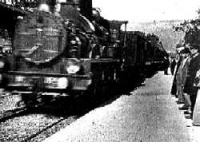Experiments with cinematic time
From The Art and Popular Culture Encyclopedia
(Difference between revisions)
| Revision as of 20:16, 3 April 2008 Jahsonic (Talk | contribs) ← Previous diff |
Current revision Jahsonic (Talk | contribs) |
||
| Line 1: | Line 1: | ||
| + | [[Image:Arrival of a Train at La Ciotat, 1895.jpg|thumb|right|200px|This page '''''{{PAGENAME}}''''' is part of the [[film]] series.<br>Illustration: screen shot from ''[[L'arrivée d'un train en gare de La Ciotat]]'']] | ||
| {{Template}} | {{Template}} | ||
| - | :''See [[reverse chronology]], [[Nonlinear (arts)|nonlinearity]]'' | ||
| - | '''Experiments with cinematic time''' is a concept in cinema concerned with [[fragmentation]] of [[narrative]] and [[nonlinearity]]. Has cinematic time influenced literature? See ''[[Time's Arrow]]''. | ||
| - | Some films experimenting with cinematic time: ''[[Rashomon]]'' (1950) - ''[[Last Year at Marienbad]]'' (1961) - ''[[Run Lola Run]]'' (1998) - ''[[Groundhog Day]]'' (1993) - ''[[Memento]]'' (2000) - ''[[Irréversible]]'' (2002) | + | '''Experiments with cinematic time''' is a concept in cinema concerned with [[fragmentation]] of [[narrative]] and with [[Nonlinear narrative|nonlinearity of narrative]]. |
| - | Some films concerned with time travel: ''[[La Jetée]]'' (1962) - ''[[The Terminator]]'' (1984) - ''[[Back to the Future]]'' (1985) | + | Some films experimenting with cinematic time are ''[[Rashomon]]'' (1950), ''[[Last Year at Marienbad]]'' (1961), ''[[Run Lola Run]]'' (1998), ''[[Groundhog Day (film)|Groundhog Day]]'' (1993), ''[[Memento]]'' (2000), ''[[Irréversible]]'' (2002). |
| + | Some films concerned with time travel are ''[[La Jetée]]'' (1962), ''[[The Terminator]]'' (1984) and ''[[Back to the Future]]'' (1985). | ||
| - | == External links == | + | Has cinematic time influenced literature? The case of ''[[Time's Arrow]]'' is an interesting one. The novel mimics the playing backwards of a film. |
| - | *[http://www.praxisfilm.com/en/libraryresources/praxisnewsletters/fall2002newsletter/default.aspx Patricia Gruben] | + | |
| - | *http://www.wwnorton.com/nrl/film/movies/movies_Ch02WhatIsANarrative.pdf [May 2004] | + | |
| == Further reading == | == Further reading == | ||
| - | ''[[The Emergence of Cinematic Time : Modernity, Contingency, the Archive]]'' (2002) by Mary Ann Doane{{GFDL}} | + | *''[[The Emergence of Cinematic Time : Modernity, Contingency, the Archive]]'' (2002) by Mary Ann Doane |
| + | ==See also== | ||
| + | :''See [[reverse chronology]], [[Nonlinear_(arts)#Film|nonlinearity in film]], [[timeline of nonlinear films]]'' | ||
| + | |||
| + | {{GFDL}} | ||
Current revision

This page Experiments with cinematic time is part of the film series.
Illustration: screen shot from L'arrivée d'un train en gare de La Ciotat
Illustration: screen shot from L'arrivée d'un train en gare de La Ciotat
|
Related e |
|
Featured: |
Experiments with cinematic time is a concept in cinema concerned with fragmentation of narrative and with nonlinearity of narrative.
Some films experimenting with cinematic time are Rashomon (1950), Last Year at Marienbad (1961), Run Lola Run (1998), Groundhog Day (1993), Memento (2000), Irréversible (2002).
Some films concerned with time travel are La Jetée (1962), The Terminator (1984) and Back to the Future (1985).
Has cinematic time influenced literature? The case of Time's Arrow is an interesting one. The novel mimics the playing backwards of a film.
[edit]
Further reading
- The Emergence of Cinematic Time : Modernity, Contingency, the Archive (2002) by Mary Ann Doane
[edit]
See also
Unless indicated otherwise, the text in this article is either based on Wikipedia article "Experiments with cinematic time" or another language Wikipedia page thereof used under the terms of the GNU Free Documentation License; or on research by Jahsonic and friends. See Art and Popular Culture's copyright notice.

